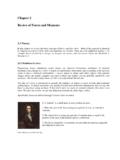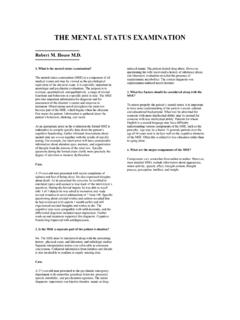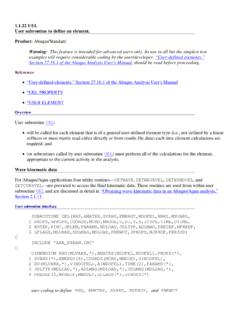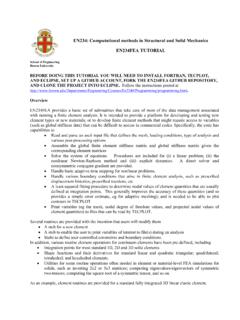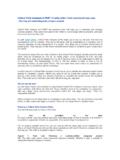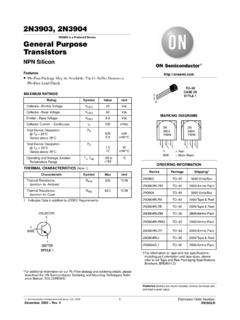Transcription of 17. Jones Matrices & Mueller Matrices
1 17. Jones Matrices & Mueller MatricesJones MatricesRotation of coordinates - the rotation matrixStokes Parameters and unpolarized lightMueller MatricesR. Clark Jones (1916 - 2004)Sir George G. Stokes(1819 - 1903)Hans Mueller (1900 - 1965)2211 xxxyyxyxyEEEEEEEEEED efine the polarization state of a field as a 2D vector Jones vector containing the two complex amplitudes: Jones vectors describe the polarization state of a waveA few examples: 0 linear (x) polarization: Ey/Ex = 0linear (arbitrary angle) polarization: Ey/Ex= tan right or left circular polarization: Ey/Ex= j10 1tan 1j (normalized to length of unity )To model the effect of a medium on light'spolarization state, we use Jones A11101201210220xxyyxyEaEaEEaEaE This yields:1000x AFor example, an x-polarizer can be written:0010010000xxxyEEEEE ASo:Since we can write a polarization state as a ( Jones ) vector, we use Matrices , A, to transform them from the input polarization, E0, to the output polarization, aaaaAThis should be thought of as a transfer Jones matricesA y-polarizer.
2 0001y A1001 HWP AA half-wave plate:A quarter-wave plate:100 QWPjA101 101 jj101 1011 1 10 1 1011 1 A half-wave plate rotates 45-degree-polarization to -45-degree, and vice Clark Jones (1916 - 2004)The orientation of a wave plate that a quarter-wave plate only converts linear to circular if the input polarization is 45 .If it sees, say, x polarization, the input is Matrices are an extremely useful way to keep track of all 1000j AQWPWave plate w/ axes at 0 or 90 0 or 90 PolarizerA wave plate exampleWhat does a quarter-wave plate do if the input polarization is linear but at an arbitrary angle? 1110tantan0 jj AQWPEinEoutFor arbitrary , this is an elliptical polarization. = 30 = 45 = 60 Jones Matrices for standard componentsRotated Jones Matrices 0011' and 'cos( )sin( )sin( )cos( )EREERER Rotation of a vector by an angle means multiply by the rotation matrix:where: 111 00' ERER ERR R E AARotating E1by and inserting the identity matrix R( )-1R( ), we have: 1'RR AAThus: 11000 ''' RRRERREE AAAWhat about when the polarizer or wave plate responsible for the transfer function Ais rotated by some angle, ?
3 Rotated Jones vector of the inputrotated Jones vector of the outputRotated Jones matrix for a polarizer cos( )sin( )1 0cos( )sin( )sin( )cos( )0 0sin( ) cos( )xA 1' RR AAcos( )sin( )cos( ) sin( )sin( )cos( )00 22cos ( )cos( ) sin( )cos( ) sin( )sin ( ) 10xA for a small angle Example: apply this to an x polarizer. 1/ 2 1/ 2451/ 2 1/ 2xA So, for example:To model the effect of many media on light's polarization state, we use many Jones AAAThe order may look counter-intuitive, but order matters!The aggregate effect of multiple components or objects can be described by the productof the Jones matrix for each inputoutputtransfer functionMultiplying Jones MatricesCrossed polarizers:xyz10yxEE AA0E1Ex-poly-pol00 10 0001 00 00 yxAAso no light leaks through. 00 10 00100 yxAAUncrossed polarizers(by a slight angle ):0E1 Erotatedx-poly-pol 0000xxyyxEEEEE yxAASoIout 2 Iin,xMultiplying Jones Matricesxyz0Ex-pol45 -pol1Ey-polNow, it is easy to compute how inserting a third polarizer between two crossed polarizersleads to larger AAA4511000010221001 1 1 00222 yxAAAThus:,1,,00011022xinyinxinEEEE The third polarizer, between the other two, makes the transmitted wave light ( , sunlight, light bulbs, etc.)
4 Is unpolarizedThe direction of the E vector is randomly changing. But, it is always perpendicular to the propagation lightnatural lightLight with very complex polarizationvs. position is "unpolarized."If the polarization vs. position is unresolvable, we call this unpolarized. Otherwise, we refer to this light as locally polarized or partially polarized. Light that has scattered multiple times, or that has scattered randomly, often becomes unpolarized as a , light from the blue sky is polarized, so when viewed through a polarizer it looks much darker. Light from clouds is unpolarized, so its intensity is reduced by only 50%.When the phases of the x- and y-polarizations fluctuate, we say the light is "unpolarized."As long as the time-varying relative phase, x(t) y(t), fluctuates, the light will not remain in a single polarization state and hence is unpolarized. 001exp yyxxEjtjtE In practice, the amplitudes are also functions of time!
5 The polarization state ( Jones vector) is:where x(t) and y(t) are functions that vary on a time scale slower thanthe period of the wave, but faster than you can measure. 00(,) Reexp(,) Reexp xxxyyyEztEjkz ttEztEjkz tt Stokes Parameters#0detects #1detects horizontally #2detects +45 #3detects right circularly cannot use Jones vectors to describe something that is rapidly fluctuating like this. So, to treat fully, partially, or unpolarized light, we use a different scheme. We define "Stokes parameters."Suppose we have four detectors, three with polarizers in front of them:S0 I0S1 2I1 I0S2 2I2 I0S3 2I3 I0 The Stokes parameters:Note that these quantities are time-averaged, so even randomly polarized light will give a well-defined of the Stokes ParametersS0 I0S1 2I1 I0S2 2I2 I0S3 2I3 I0 The Stokes parameters:S0= the total irradianceS1= the excess in intensity of light transmitted by a horizontal polarizer over light transmitted by a vertical polarizerS2= the excess in intensity of light transmitted by a 45 polarizer over light transmitted by a 135 polarizerS3= the excess in intensity of light transmitted by a RCP filter over light transmitted by a LCP filterWhat we mean when we say unpolarized light.
6 All three of these excess quantities are zeroDegree of polarization 1/22221230 Degree of polarization = S + S + S/ S= 1 for polarized light= 0 for unpolarized lightIf any of the excess quantities (S1, S2, or S3) are non-zero, then the wave has some degree of polarization. We can quantify this by defining the degree of polarization :Note that this quantity can never be greater than unity , since S0is the total is not the same as the degree of polarization defined in the homework problem, which was only defined for fully polarized part: 222 1232123 SSSSSSS unpolarized part: 222 01231 SSSS0S00 The Stokes vectorWe can write the four Stokes parameters in vector form:0123 SSSSS The Stokes vector Scontain information about both the polarized part and the unpolarized part of the S(1)+ S(2)Stokes vectors (and Jones vectors for comparison)Sir George G. Stokes(1819 - 1903) Mueller Matrices multiply Stokes vectorsTo model the effects of more than one medium on the polarizationstate, just multiply the input polarization Stokes vector by all of the Mueller Matrices :Sout= M3M2M1 Sin(just like Jones Matrices multiplying Jones vectors, except that the vectors have four elements instead of two)SoutSinM1M2M3We can define Matrices that multiply Stokes vectors, just as Jones Matrices multiply Jones vectors.
7 These are called Mueller Matrices . Mueller Matrices (and Jones Matrices for comparison)With Stokes vectors and Mueller Matrices , we can describe light with arbitrarily complicated combination of polarized and unpolarized Mueller (1900 - 1965)
